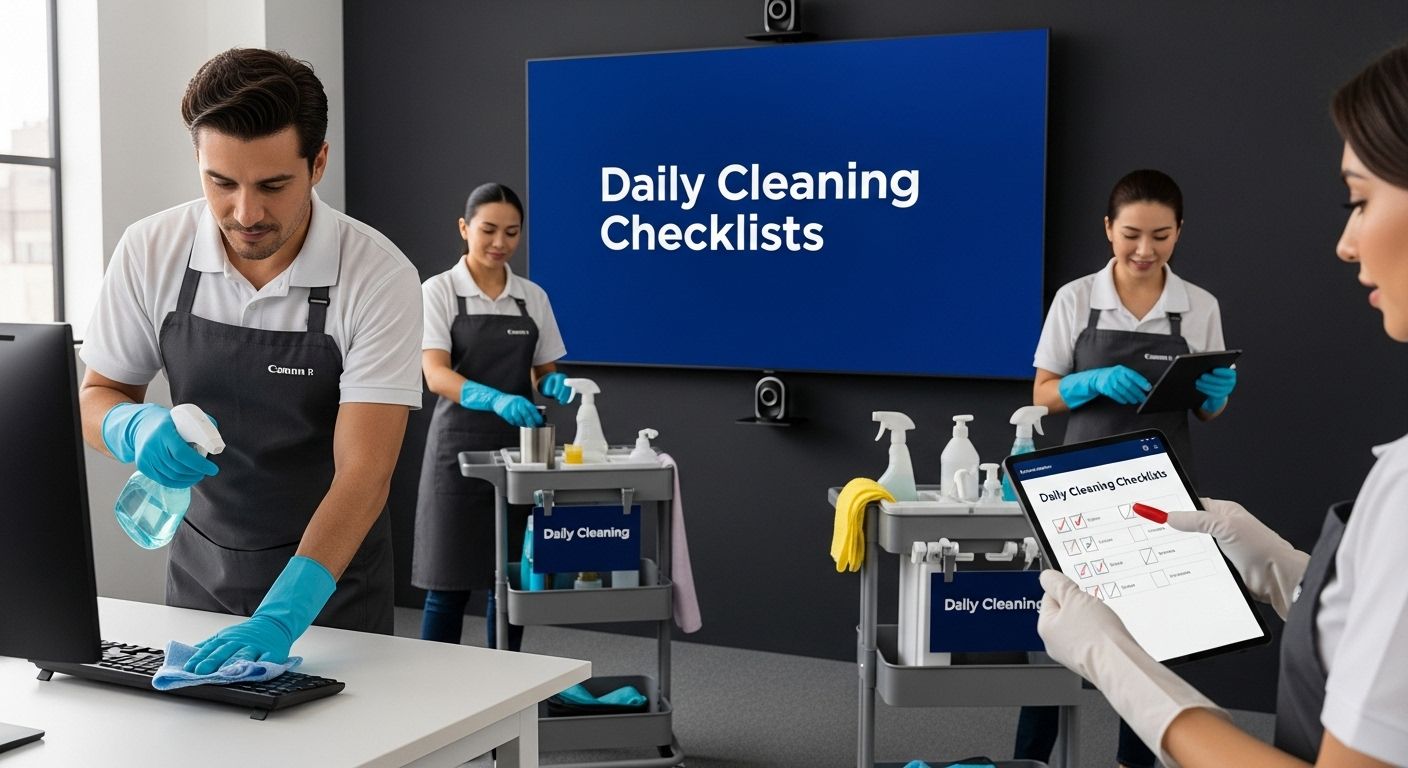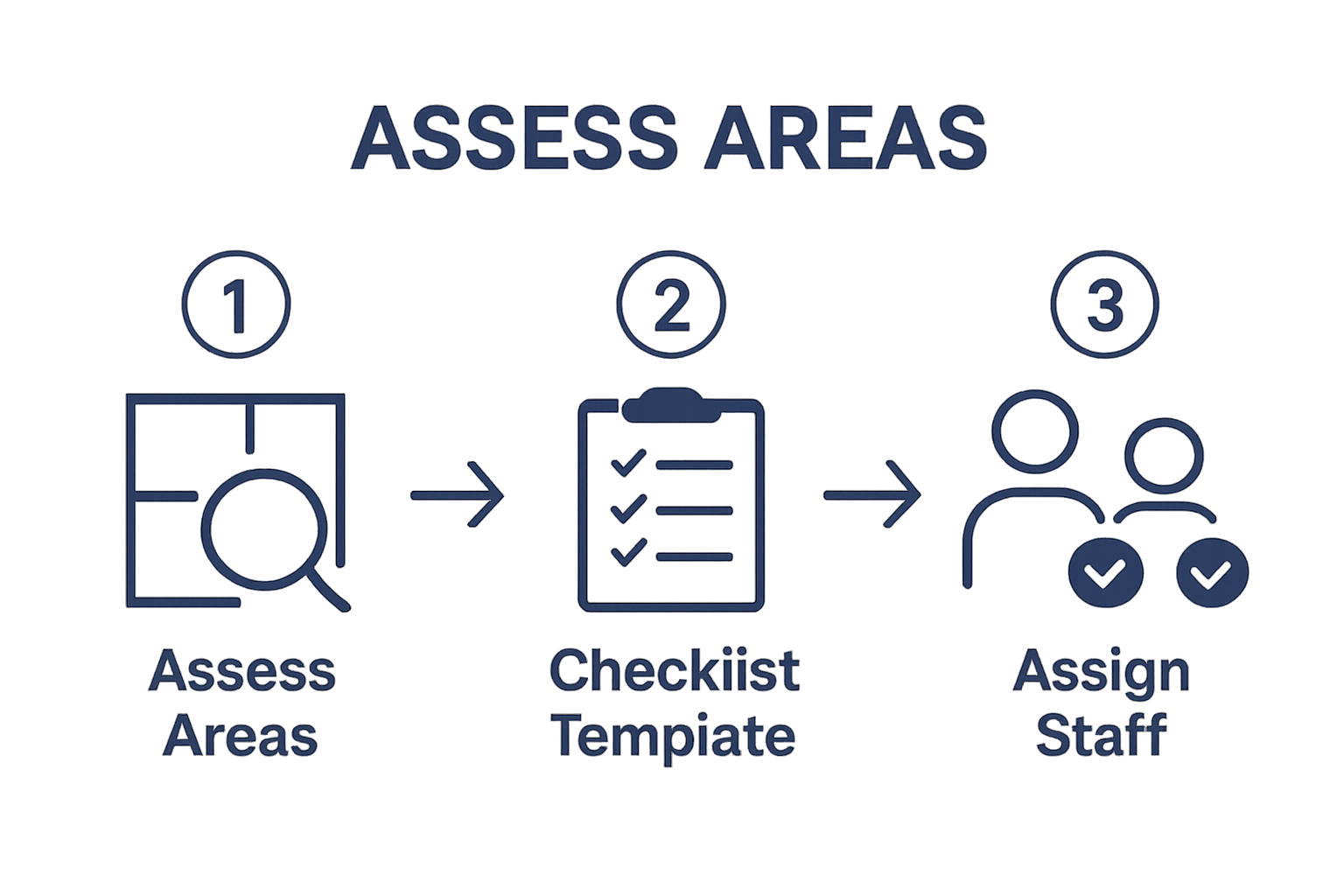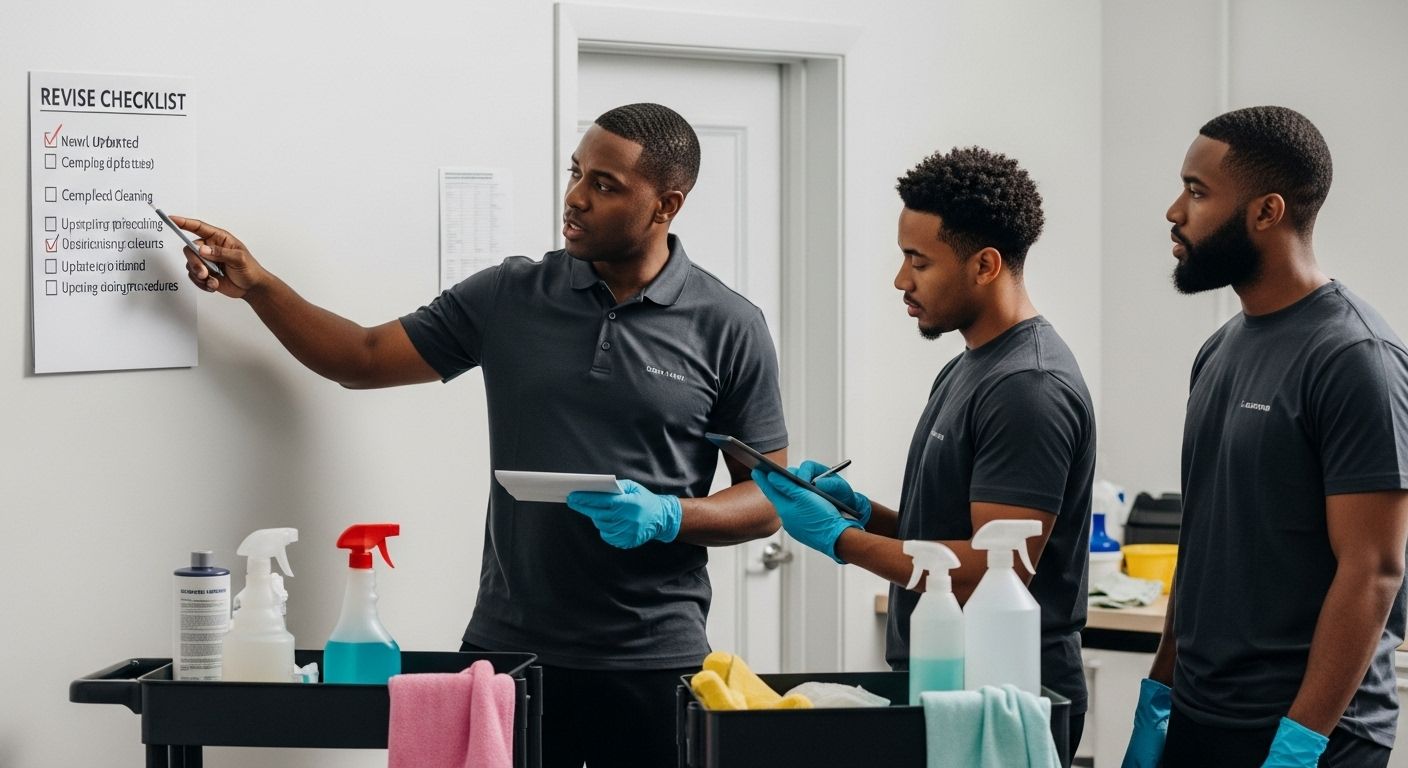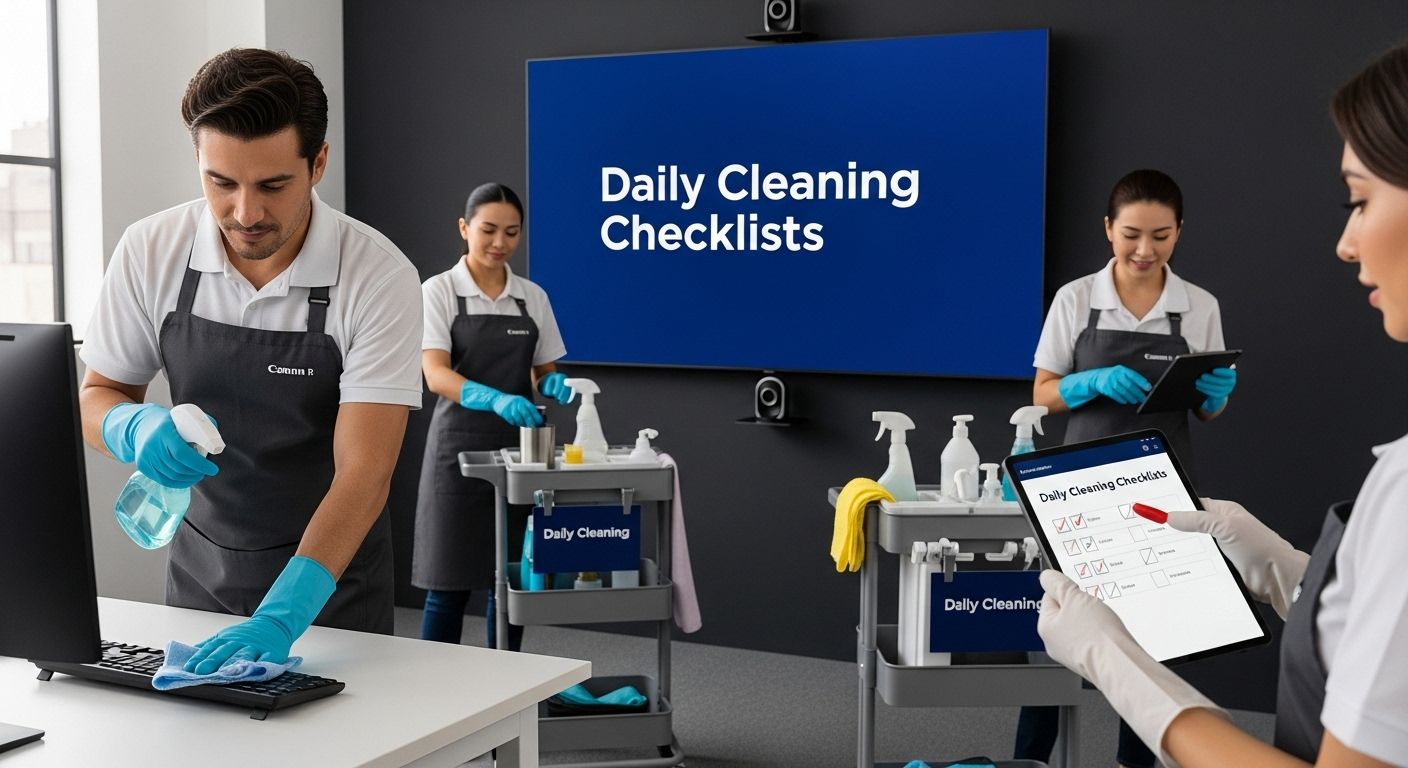
Daily cleaning can feel endless, but most offices miss huge opportunities for improvement hiding in plain sight. Over half of businesses waste precious hours each week simply because their cleaning routines lack clear structure or responsibility. What most people never realize is that a simple checklist system, paired with periodic updates, can actually reclaim hours and boost cleaning results without extra effort.
Table of Contents
- Step 1: Define Your Cleaning Scope And Areas
- Step 2: Create A Daily Cleaning Checklist Template
- Step 3: Assign Responsibilities To Your Cleaning Staff
- Step 4: Implement The Daily Cleaning Routine
- Step 5: Monitor And Evaluate Cleaning Effectiveness
- Step 6: Revise And Update Your Checklists As Needed
Quick Summary
| Key Point | Explanation |
|---|---|
| 1. Define cleaning scope clearly | Assess each area for specific cleaning needs and challenges to ensure a targeted approach. |
| 2. Create a detailed checklist template | Develop a template that captures essential tasks, frequency, and responsible personnel for systematic maintenance. |
| 3. Assign responsibilities effectively | Match cleaning tasks with staff skills, ensuring clear accountability and balanced workloads to optimize performance. |
| 4. Implement a structured cleaning routine | Follow a logical sequence for cleaning tasks to maximize efficiency and minimize disruption in the workplace. |
| 5. Regularly monitor and evaluate effectiveness | Establish performance metrics and feedback mechanisms to continually improve cleaning standards and processes. |
Step 1: Define Your Cleaning Scope and Areas
Establishing a strategic approach to daily cleaning starts with precisely defining your cleaning scope and areas. This foundational step transforms random cleaning efforts into a systematic, efficient process that maximizes productivity and ensures comprehensive coverage of your space.
Begin by conducting a thorough visual assessment of your entire environment. Walk through each room or zone, noting specific surfaces, high traffic areas, and unique cleaning requirements. Professional facility managers understand that not all spaces demand identical cleaning protocols. A warehouse loading dock requires different attention compared to an administrative office reception area.
Key Areas to Systematically Evaluate:
- Floors and floor surfaces
- Workstations and desk areas
- Common areas like break rooms and lobbies
- Restrooms and sanitation zones
- Storage spaces and utility rooms
- Equipment and machinery surfaces
Consider the frequency and intensity of cleaning needed for each identified zone. Some areas might require daily deep cleaning, while others need minimal maintenance. Factors like foot traffic, type of work performed, and potential contamination risks will influence your cleaning strategy.
Creating a detailed spatial cleaning map helps visualize your approach. Divide your environment into logical sections with clear boundaries. This mapping technique allows you to allocate appropriate time, resources, and cleaning techniques for each specific area. Professional cleaning checklists thrive on this level of granular planning.
The table below outlines essential components of a daily cleaning checklist template, making it easier to standardize and verify the cleaning process throughout your organization.
| Component | Purpose |
|---|---|
| Area/Zone Description | Identifies the specific space to be cleaned |
| Specific Cleaning Tasks | Details exactly what must be cleaned in each area |
| Cleaning Frequency | Indicates how often each task should be performed |
| Responsible Personnel | Assigns someone to the task for accountability |
| Completion Status | Tracks progress and completion of tasks |
| Quality Verification | Ensures standards are met through checks |
Remember that your cleaning scope is not static. Regularly reassess your defined areas, adapting to changes in workspace layout, organizational needs, or emerging hygiene standards. A dynamic, flexible approach ensures your daily cleaning checklists remain relevant and effective.
Successful scope definition means you can confidently answer: What needs cleaning? How often? With what intensity? Your systematic evaluation will set the stage for a robust, comprehensive cleaning strategy.
Below is a table summarizing the main steps for establishing an efficient daily cleaning checklist system. Use this overview to quickly understand each stage, its focus, and the intended outcome.
| Step | Focus Area | Key Outcome |
|---|---|---|
| 1 | Define Cleaning Scope and Areas | Clear division and understanding of all cleaning zones and needs |
| 2 | Create a Daily Cleaning Checklist Template | Structured template guiding daily cleaning tasks |
| 3 | Assign Responsibilities to Cleaning Staff | Matched tasks and clear accountability |
| 4 | Implement the Daily Cleaning Routine | Seamless, efficient execution of all assigned tasks |
| 5 | Monitor and Evaluate Cleaning Effectiveness | Continuous measurement and feedback loop |
| 6 | Revise and Update Checklists | Ongoing improvement and alignment with best practices |
Step 2: Create a Daily Cleaning Checklist Template
Transforming your cleaning strategy from conceptual to actionable requires developing a comprehensive daily cleaning checklist template. This critical document serves as your operational blueprint, guiding cleaning personnel through systematic and consistent maintenance protocols.
Start by designing a clear, logical template that reflects the spatial assessment completed in your initial scope definition. Your template should provide a structured approach that captures every cleaning task with precision and clarity. Digital spreadsheet platforms like Google Sheets or Microsoft Excel offer excellent flexibility for creating adaptable checklists that can be easily modified and shared across teams.
Essential Template Components:
- Area/Zone Description
- Specific Cleaning Tasks
- Cleaning Frequency
- Responsible Personnel
- Completion Status
- Quality Verification
Consider incorporating visual elements that enhance usability. Color coding can indicate task priority or completion status. For instance, green might represent completed tasks, yellow for ongoing tasks, and red for urgent or overdue cleaning requirements. This visual approach helps management quickly assess cleaning progress and identify potential bottlenecks.
According to the Centers for Disease Control and Prevention, an effective cleaning checklist must include detailed task descriptions, specifying not just what needs cleaning, but precisely how each surface or area should be addressed. This means including specific instructions like cleaning direction, recommended cleaning agents, and required personal protective equipment.
Develop your template with flexibility in mind. While standardization is crucial, your checklist should accommodate variations in different environments. Include sections for special notes, equipment requirements, and potential hazards unique to specific areas. This adaptability ensures your template remains a living document that can evolve with changing organizational needs.
The ultimate goal of your daily cleaning checklist template is creating a standardized system that reduces ambiguity, increases accountability, and ensures consistent cleaning quality.

When designed thoughtfully, this template becomes more than a document - it becomes a comprehensive cleaning management tool that drives operational excellence.
Step 3: Assign Responsibilities to Your Cleaning Staff
Successful implementation of daily cleaning checklists hinges on strategic responsibility assignment. This crucial step transforms your meticulously crafted cleaning template into a living, actionable system by clearly defining who does what, when, and how.
Begin by evaluating your staff’s individual strengths, skills, and specialized training. Not all cleaning team members possess identical capabilities or expertise. Some might excel at detailed surface sanitization, while others demonstrate superior efficiency in managing complex equipment or high traffic zones. Matching team members to tasks that align with their individual competencies maximizes overall cleaning performance and job satisfaction.
Key Responsibility Assignment Principles:
- Match individual skills with specific cleaning tasks
- Establish clear accountability mechanisms
- Create balanced workload distributions
- Define performance expectations
- Implement rotation strategies
According to the Centers for Disease Control and Prevention, developing a structured approach to task allocation is fundamental to maintaining consistent cleaning standards. This means creating a comprehensive assignment matrix that goes beyond simple task distribution. Consider implementing a rotation system that prevents monotony and ensures all team members develop versatile skills across different cleaning environments.
Develop a transparent communication protocol where each staff member understands their specific responsibilities. This involves creating detailed job descriptions that outline not just tasks, but expected quality standards, required equipment, and completion timelines. Digital tools like shared spreadsheets or dedicated cleaning management software can help track assignments and monitor progress in real time.
Consider implementing a peer review and cross-training approach. When team members occasionally review each other’s work, it promotes accountability and helps identify potential improvement areas. This collaborative strategy transforms cleaning from an individual task to a collective organizational commitment.
The ultimate goal is creating a responsibility framework that is flexible, fair, and focused on maintaining exceptional cleaning standards. By thoughtfully assigning and managing cleaning responsibilities, you transform your team from simple maintenance workers into strategic partners in maintaining a clean, safe, and professional environment.
Step 4: Implement the Daily Cleaning Routine
Transitioning from planning to execution, implementing your daily cleaning routine requires precision, consistency, and a strategic approach. This step transforms your carefully developed checklist into a living, breathing operational protocol that maintains environmental hygiene and organizational standards.
Begin by establishing a clear time sequence for your cleaning activities. Most successful cleaning routines follow a logical progression that minimizes disruption and maximizes efficiency. Start with broader area preparations, such as clearing surfaces and removing debris, before moving into detailed cleaning and sanitization processes. Consider the natural workflow of your specific environment, scheduling cleaning tasks during periods of minimal operational interference.
Critical Implementation Strategies:
- Start with highest priority areas
- Use systematic cleaning techniques
- Minimize cross contamination
- Maintain consistent quality standards
- Document completion of each task
According to the Washington State Department of Health, effective cleaning goes beyond simply wiping surfaces. It requires understanding proper techniques, using appropriate cleaning agents, and following a structured approach that removes dirt, germs, and potential contaminants systematically.
Equip your cleaning team with high quality, purpose specific tools and cleaning solutions. Invest in microfiber cloths, color coded cleaning materials, and ergonomic equipment that supports efficient cleaning processes. Train staff to use these tools correctly, emphasizing techniques that maximize cleaning effectiveness while minimizing physical strain.
Develop a real time tracking mechanism to monitor routine progress. Digital tools like mobile apps or cloud based spreadsheets can help staff log completed tasks, record any challenges encountered, and provide immediate visibility into cleaning status. This approach creates accountability and allows management to quickly identify and address any potential gaps in the cleaning routine.
Remember that implementation is not a one time event but an ongoing process of refinement. Regularly review and adjust your cleaning routine based on performance data, changing organizational needs, and emerging best practices. Flexibility and continuous improvement are key to maintaining a robust and effective daily cleaning strategy.
Step 5: Monitor and Evaluate Cleaning Effectiveness
Monitoring and evaluating cleaning effectiveness transforms your cleaning routine from a static process to a dynamic, continuously improving system. This critical step ensures that your carefully developed cleaning protocols deliver consistent, high quality results that meet and exceed organizational standards.
Begin by establishing clear performance metrics that go beyond surface level observations. These metrics should encompass quantitative and qualitative measurements that provide a comprehensive view of cleaning quality. Consider developing a scoring system that evaluates factors like thoroughness, time efficiency, adherence to established protocols, and overall environmental hygiene.
Comprehensive Evaluation Strategies:
- Conduct regular visual inspections
- Implement random spot checks
- Track cleaning time and resource utilization
- Gather feedback from staff and occupants
- Use objective measurement tools
According to the Centers for Disease Control and Prevention, effective monitoring requires a multifaceted approach. This means combining direct observation techniques with advanced measurement methods. Consider utilizing technologies like ATP bioluminescence testing, which can quickly assess surface cleanliness by measuring organic residue levels, providing objective data about cleaning performance.
Develop a structured feedback mechanism that allows cleaning staff to report challenges, suggest improvements, and provide insights into their daily experiences. This collaborative approach transforms monitoring from a top down assessment to a collaborative improvement process. Regular team discussions can uncover subtle inefficiencies or innovative solutions that might otherwise go unnoticed.
Integrate digital tracking tools that provide real time performance insights. Utilize software platforms that can generate comprehensive reports, track key performance indicators, and highlight trends over time. These tools enable management to identify patterns, recognize outstanding performers, and quickly address any consistent performance gaps.
Remember that monitoring is not about punishment but continuous improvement. Approach evaluation as a constructive process that supports staff development and organizational excellence. By creating a culture of transparency, accountability, and ongoing learning, you transform cleaning from a routine task to a strategic organizational function that directly impacts environmental quality and operational success.
Step 6: Revise and Update Your Checklists as Needed
The most effective cleaning systems are not static documents but living frameworks that evolve with organizational needs, technological advancements, and emerging best practices. Regularly revising and updating your daily cleaning checklists ensures continued relevance, efficiency, and alignment with current operational requirements.
Establish a systematic review process that goes beyond casual observations. Schedule formal quarterly or semi annual checklist evaluations where you comprehensively examine every aspect of your cleaning protocol. This deliberate approach allows you to identify subtle inefficiencies, incorporate staff feedback, and integrate new cleaning technologies or methodologies that could enhance overall performance.
Strategic Revision Considerations:
- Analyze performance metrics from monitoring phase
- Solicit feedback from cleaning staff
- Review industry best practices
- Assess changes in organizational environment
- Incorporate technological advancements
According to the Occupational Safety and Health Administration, workplace safety protocols require ongoing evaluation and adaptation. The same principle applies to cleaning checklists. Create a culture of continuous improvement where every team member understands that the current system is not perfect but always capable of refinement.
Develop a structured feedback mechanism that makes updating transparent and collaborative. Implement digital suggestion platforms or regular team meetings where cleaning staff can share insights, challenges, and potential improvements. These frontline perspectives often reveal optimization opportunities that management might overlook.
Consider technological solutions that can streamline the revision process. Digital checklist management platforms allow real time updates, version tracking, and instant team communication. These tools can help you quickly propagate changes, ensure everyone receives the most current protocols, and maintain a clear revision history.
Remember that updating is not just about adding or removing tasks. It is an opportunity to streamline processes, eliminate redundancies, and develop more intelligent cleaning strategies. Approach each revision as a strategic planning session that seeks to enhance efficiency, reduce resource consumption, and improve overall cleaning quality. Your willingness to adapt becomes your greatest asset in maintaining an exceptional cleaning environment.

Take Your Cleaning Checklist to the Next Level with Professional Floor Mats
Are you searching for a complete cleaning solution that truly supports the daily routines and goals described in your checklist? One of the top challenges highlighted in creating efficient daily cleaning checklists is maintaining high-traffic areas where dirt, water, and debris quickly accumulate. Even with a well-structured checklist and an engaged staff, achieving consistent results can be difficult if your entry points and walkways lack proper protection. Your cleaning strategy is only as efficient as the tools you put in place to minimize mess at the source.
Investing in commercial and industrial floor mats is a proven way to reinforce your cleaning protocols, reduce workload, and protect your facility from tracked-in contaminants. Discover our selection at Mats4U.com, where you can find a wide range of mat types designed specifically for demanding environments. Adding the right mats means fewer cleaning cycles and a safer, more professional workspace for your team. Ready to elevate your cleaning checklist outcomes for 2025? Visit Mats4U.com today and explore mat solutions that make maintaining your space easier than ever.
Frequently Asked Questions
What should I include in a daily cleaning checklist?
Your daily cleaning checklist should include area/zone descriptions, specific cleaning tasks, cleaning frequency, responsible personnel, completion status, and quality verification. This structure helps ensure thorough and systematic cleaning.
How often should I revise my cleaning checklists?
It is recommended to revise your cleaning checklists regularly, ideally on a quarterly or semi-annual basis. This allows you to incorporate feedback, analyze performance metrics, and adapt to any changes in your cleaning environment or protocols.
How can I ensure effective cleaning implementation in my organization?
To ensure effective cleaning implementation, establish a clear time sequence for cleaning tasks, provide high-quality cleaning tools and solutions, and utilize digital tracking mechanisms to monitor progress. Training staff in proper techniques is also crucial.
What strategies can I use to evaluate cleaning effectiveness?
You can evaluate cleaning effectiveness by conducting regular inspections, implementing random spot checks, tracking time and resource utilization, gathering feedback from staff, and using objective measurement tools like ATP bioluminescence testing to assess surface cleanliness.







